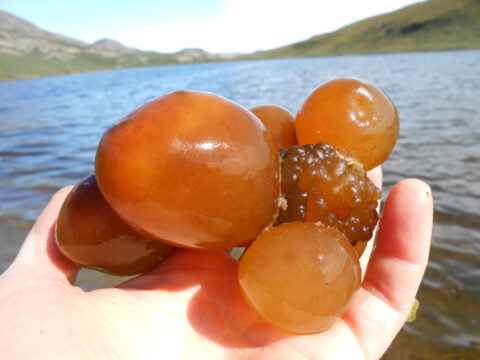
Arctic lakes are stark environments full of extremes. The creatures that live in them must endure blasting ultraviolet radiation for 24 hours a day in the summer, months of icy darkness in the winter, and low levels of life-sustaining nutrients. Still, some manage to survive and even flourish under those severe conditions: Take, for example, the sea tomato.
Sea tomatoes are round, plump colonies of toxin-producing cyanobacteria. Scientists reported last week that they have recently observed sea tomatoes stacking up on some Greenland lake bottoms like tomatoes piled haphazardly on a grocery display.
The colonies start as single cells, then grow into gelatinous globules that can be as big as softballs, said Jessica Trout-Haney, a biology graduate student at Dartmouth College in Hanover, N.H. When Trout-Haney and her colleagues went to southwest Greenland to investigate naturally occurring toxins in Arctic lakes, they were surprised by what they saw.
“The bottoms of the lakes were covered in these balls. Greenlanders call them ‘sea tomatoes.’”
“The bottoms of the lakes were covered in these balls,” Trout-Haney said. “Greenlanders call them ‘sea tomatoes.’”
Although biologists have run across sea tomatoes before, the colonies in some polar lakes stand out for their “sheer size and abundance,” Trout-Haney said. The largest colonies may be 25 years old, she noted.
Examining the Arctic
Studies on toxic cyanobacteria have typically focused on bloom-forming species in temperate or tropical locations, Trout-Haney said, because researchers thought the colder lakes of the polar regions wouldn’t harbor enough cyanobacteria to produce much toxin.
To test that assumption, the researchers sampled water from lakes in an ice-free area of tundra near Kangerlussuaq, Greenland. The team detected microcystin, the most widespread toxin produced by cyanobacteria, in all 19 lakes they tested, they reported on 18 December at the 2015 American Geophysical Union Fall Meeting in San Francisco, Calif.
Microcystin causes liver damage to humans and animals that consume it, Trout-Haney said. The levels the scientists found were low enough that they wouldn’t cause acute sickness. Still, “low level ingestion over time is also bad—it wears down your system,” Trout-Haney said.
Although sea tomatoes release microcystin into the water where they live, they aren’t the only source of the toxin.
Although sea tomatoes release microcystin into the water where they live, they aren’t the only source of the toxin, Trout-Haney said. Even water from lakes where they’re absent tested positive for microcystin, suggesting that other organisms also produce it.
Phytoplankton—tiny photosynthesizing creatures that live underwater—may be the culprit, Trout-Haney said. Turbulent waves sometimes launch the minute organisms into the air, which may provide a pathway for toxins to spread to land, Trout-Haney said—a possibility the team intends to investigate in the future.
Don’t Drink the Water
“I was really surprised at how high the microcystin levels were,” said Hilary Dugan, a limnologist at the University of Wisconsin–Madison, who was not involved in the study. Scientists generally think of polar lakes as pristine environments that couldn’t support organisms like sea tomatoes because of scarce nutrients. This research highlights the importance of testing assumptions like that, Dugan said.
When you’re out in the field “working in these environments, you just drink the lake water,” Dugan added, a practice she might reconsider in the future.
—Emily Benson, Science Communication Program Graduate Student, University of California, Santa Cruz; email: [email protected]; Twitter: @erbenson1
Citation: Benson, E. (2015), Giant balls of bacteria pile up on Arctic lake beds, ooze toxin, Eos, 96, doi:10.1029/2015EO042397. Published on 23 December 2015.
Text © 2015. The authors. CC BY-NC 3.0
Except where otherwise noted, images are subject to copyright. Any reuse without express permission from the copyright owner is prohibited.

